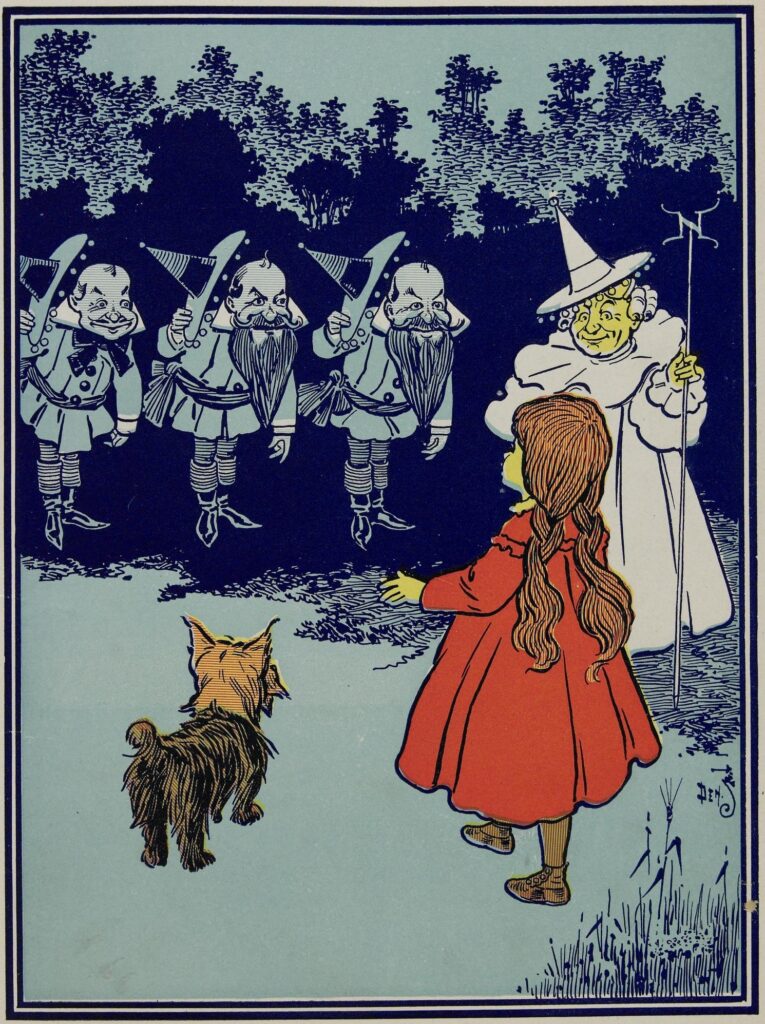4. Those Oz People Took My Kingdom Away
This background may raise questions regarding the nature of how Ozma and Dorothy “civilize” Oz over the series. I have been using this imperialist term deliberately. In The Wonderful Wizard, Baum introduces Oz with this language. The Good Witch of the North asks if Kansas is “a civilized country.” Dorothy answers in the affirmative. The Witch continues, “But, you see, the Land of Oz has never been civilized, for we are cut off from all the rest of the world” (24). Kansas only became “civilized” in the sense of a genocidal theft of its land from the peoples the white supremacist US project deemed “uncivilized.” The notion is imperialistic and implies the logic of violence present in the author’s own society.

The specific definition of civilization that the Good Witch uses hinges on the use of magic. “In civilized countries I believe there are no witches left; nor wizards, nor sorceresses, nor magicians. But, you see, the Land of Oz has never been civilized” (Wonderful Wizard 23). A country with numerous wizards and witches is uncivilized. In Oz’s world, magic is distinct from the existence of strange creatures: a fairy is an immortal being but not magic unless the individual fairy is also a wizard, magician, sorceress, etc.
Appropriately, Ozma’s most prominent, consistent edict, as demonstrated in The Patchwork Girl of Oz,The Scarecrow of Oz, The Lost Princess of Oz, and The Magic of Oz, is that the practice of magic is illegal save for her, Glinda, and the Wizard. (Glinda replaces the Good Witch of the North without explanation.) “Of course witches are forbidden to exist in the Land of Oz” (Scarecrow 153). Despite his many inconsistencies, Baum continues to associate being civilized with the limited practice of magic at least as of the eighth book: “it is unlawful in all civilized countries for anyone to transform a person into a dove by muttering the words Ruggedo used” (Tik-Tok 191, emphasis mine). This “civilization” is also pivotal for the functioning of Ozma’s dictatorship, which reserves control of magic, in other words the technology of coercive surveillance and authority, to Glinda, Ozma, and the Wizard.
Ozma conspicuously keeps a huge palace, luxurious apartments, highly deferential servants, and other luxuries shared only with Dorothy and, later, Betsy Bobbin and Trot Griffiths. So do at least Glinda, whose servants carry her around on a golden palanquin, and the Tin Woodman, who identifies himself as an “Absolute Monarch” whom none challenge (Marvelous Land 285). Given this, commentators’ tendency to consider the civilized Oz a classless society is particularly strange. To name one of the dozens of instances, in The Magic of Oz, the Tin Woodman, after Baum explicitly reminds the reader he is the ruler of the Winkies, announces, “I am having my people make Ozma a lovely girdle set with beautiful tin nuggets. Each tin nugget will be surrounded by a circle of emeralds, just to set it off to good advantage” (68). The servants of the rulers are clearly made to expend labor and resources on behalf of their betters’ personal vanity. The stories almost never seem to consider the servant characters’ desires or personhood. They are only a background element for the protagonists who spend time being waited on in huge castles.
Recall Wagner’s claim that “Ozma’s decision-making power rests literally and absolutely in carrying out the will of the people. Embedded in a truly egalitarian system, power comes from the people; it is not exercised over them” (10). In fact, Ozma is unelected and holds sole authority over legal decisions, as seen in the trial sequence in The Patchwork Girl. Once the Wicked Witches are removed, Ozma, Glinda, and the Wizard utilize their monopoly on magic to banish dissidents such as Ann Soforth, forcibly alter the minds of people such as the Glass Cat and Kiki Aru to render them docile, determine whether to allow people into or out of Oz, and forcibly strip magic away from their subjects such as Pipt and Blinkie.
Between Ozma’s Magic Picture and Glinda’s Magic Book (later called the Book of Records), the civilized Oz is a surveillance state panopticon. The Magic Picture allows Ozma to spy on whomever she wants, anywhere, at any time, without their knowledge: “the Princess could view any part of the world she wished, and watch the actions of any one in whom she was interested” (Emerald City 193). The Magic Book, meanwhile, documents everything that happens. The Magic Picture is limited to what Ozma knows to survey, but evading Glinda’s detection is impossible: “As soon as an event takes place, anywhere in the world, it is immediately found printed in my Magic Book” (ibid. 292). After Glinda casts the enchantment that hides Oz from the outside world at the end of The Emerald City, people are trapped in Oz, unable to leave without the ruler’s permission—it is a prison, as the Wise Donkey explains in The Patchwork Girl (93).